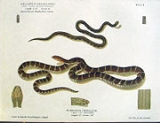
Common Krait
Overview
The common krait is a species
of genus Bungarus
found in the jungle
s of the India
n subcontinent
. It is a member of the "big four"
, species inflicting the most snakebites
in India.
The body colour varies from a dark steely blue
-black
to a pale faded bluish grey
. The average length is 0.9 metres (3 ft) but they can grow to 1.75 metres (5.7 ft). Subcaudal scales after the anal plate are not divided. It has large hexagonal scales running down its spine.
Species
In biology, a species is one of the basic units of biological classification and a taxonomic rank. A species is often defined as a group of organisms capable of interbreeding and producing fertile offspring. While in many cases this definition is adequate, more precise or differing measures are...
of genus Bungarus
Bungarus
Bungarus, commonly referred to as kraits , is a genus of venomous elapid snakes found in South and South-East Asia. There are 12 species and 5 subspecies recognized.- Distribution :...
found in the jungle
Jungle
A Jungle is an area of land in the tropics overgrown with dense vegetation.The word jungle originates from the Sanskrit word jangala which referred to uncultivated land. Although the Sanskrit word refers to "dry land", it has been suggested that an Anglo-Indian interpretation led to its...
s of the India
India
India , officially the Republic of India , is a country in South Asia. It is the seventh-largest country by geographical area, the second-most populous country with over 1.2 billion people, and the most populous democracy in the world...
n subcontinent
Subcontinent
A subcontinent is a large, relatively self-contained landmass forming a subdivision of a continent. By dictionary entries, the term subcontinent signifies "having a certain geographical or political independence" from the rest of the continent, or "a vast and more or less self-contained subdivision...
. It is a member of the "big four"
Big Four (Indian snakes)
The Big Four are the four venomous snake species responsible for causing the most snake bite cases in South Asia .The Big Four:* Indian cobra, Naja naja, probably the most famous of all Indian snakes....
, species inflicting the most snakebites
Snakebite
A snakebite is an injury caused by a bite from a snake, often resulting in puncture wounds inflicted by the animal's fangs and sometimes resulting in envenomation. Although the majority of snake species are non-venomous and typically kill their prey with constriction rather than venom, venomous...
in India.
The body colour varies from a dark steely blue
Blue
Blue is a colour, the perception of which is evoked by light having a spectrum dominated by energy with a wavelength of roughly 440–490 nm. It is considered one of the additive primary colours. On the HSV Colour Wheel, the complement of blue is yellow; that is, a colour corresponding to an equal...
-black
Black
Black is the color of objects that do not emit or reflect light in any part of the visible spectrum; they absorb all such frequencies of light...
to a pale faded bluish grey
Grey
Grey or gray is an achromatic or neutral color.Complementary colors are defined to mix to grey, either additively or subtractively, and many color models place complements opposite each other in a color wheel. To produce grey in RGB displays, the R, G, and B primary light sources are combined in...
. The average length is 0.9 metres (3 ft) but they can grow to 1.75 metres (5.7 ft). Subcaudal scales after the anal plate are not divided. It has large hexagonal scales running down its spine.
Unanswered Questions

